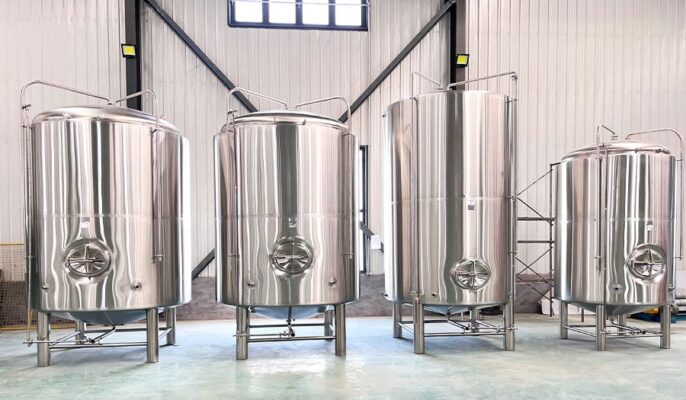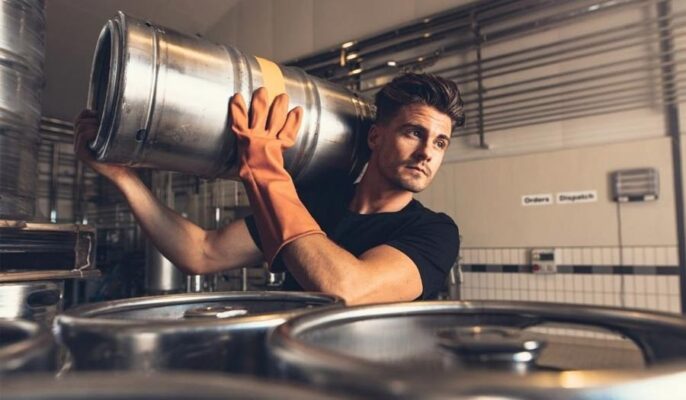In the beer brewing process, it is crucial to understand and master the nuances of each step of the process. One of the key steps in the beer-making process is cooling the boiled wort. This is a crucial process because rapid cooling of the wort can affect the flavor, aroma, and quality of the finished beer. Today’s article is about cold liquid tanks (CLT) for cooling wort. Many of our customers always wonder whether to use CLT to cool their wort. Next, join micet engineers to learn about the advantages and disadvantages of using CLT to cool wort.
What is a Cold Liquid Tank (CLT)?
CLT is the abbreviation of cold liquid tank, which is a special container used to cool and store water in breweries. The tank is usually stainless steel and placed near the brewery, close to the heat exchanger.
The cold liquid tank is welded with a cooling jacket, which means it has an inner shell and an outer shell, and the inner shell and the outer shell are filled with insulating material. Between this housing is a coil of tubing that allows the glycol from your cooling system to pass through it, allowing you to cool the water in the tank to the desired temperature.

The temperature to which the water can be cooled is approximately 1°C to 7°C, depending on the beer being brewed. Water from the CLT is pumped through a heat exchanger to cool the wort entering the FV. As cold water flows through one side of the heat exchanger, hot wort flows through the other side, causing the liquid to flash cool. This means it is immediately cooled to the temperature required for fermentation. The water does not come into contact with the beer but instead enters the hot liquid tank (HLT). The cold water “takes away” the heat from the beer, making it hotter itself. The generated hot water can be used for the next brew or for cleaning brewery equipment.
Advantages of utilizing CLT to cool wort
Maintain water at desired temperature
When using city/tap water to cool wort, the water temperature may be affected by temperature changes throughout the year. Tap water temperatures in summer can be 12-20°C higher than at other times of the year. With beer (or even ale), it can be difficult to adjust the wort to the desired temperature level. This means that the glycol in the two-stage temperature exchanger works more , resulting in a higher temperature of the glycol at the end of the wort collection. Additionally, you may need to turn off FVs in storage that are cold, otherwise they may get hot as well.
Also note that ambient temperatures are also higher (in the summer) and the entire glycol system must work harder to return the glycol temperature to normal operating levels. During the summer, your glycol system is under a lot of stress because the ambient temperatures are higher and it’s already working harder anyway.
Prepare extra warm water for cleaning or brewing next time
When you cool the wort with cold water, it creates a large amount of hot water that can be used for next brewing or washing. For example, I clean my keg the day after brew day, and I provide plenty of hot water for the job. Plus, if you decide to do a proper caustic soda brew the next day, you’ll have enough hot water to get the job done. The best way to use a single-stage tank is for back-to-back brewing. Note that the hot water produced by the wort collection can be used for the next brew.
Reduce glycol system workload
Using a single stage cold water heat exchanger means you are not using glycol to cool the wort. Thus, the glycol system has less work and you do not have to turn off the cooling of the already cooling cellar tank. Another advantage includes that a given size of glycol system is now able to cool more cellar tanks. Thus, more cellar tanks can be added at the time of installation or later when expanding.
Disadvantages of using CLT to cool wort
Having a dedicated CLT adds extra cost for piping and controls, and there’s also a fee to plug the tank into the glycol cooling system. But as we all know, boiling water is expensive. Over time, you recoup the original cost, and the recovered hot water can be used for other tasks. If brewing , each brew will provide hot water for next brews.
Sspace
CLT takes up more space. If you’re a brewpub, space is at a premium. If using a CLT will cost you a desk or two, then it’s not the best choice.
Planning
When you use CLT, you need to fill and start cooling at least 24 hours before brew day. It takes time to lower the temperature.
Without high water pressure, it may take a while to fill the tank. Also, when you fill the tank with water, you may not be able to use the water elsewhere. This means you need to plan this action in your schedule.

How big does a CLT need to be?
It depends on the size of the brewery and the beer being brewed. If you brew a beer that ferments at a lower temperature than an ale, you will need a larger CLT. Also, if you are brewing , a larger CLT is recommended. , manufacturers and brewing consultants recommend a CLT of twice the brew length. So if you have a 1,000 liter brewery, the recommended CLT is 2,000 liters. Because it gives you a cushion and also cools down the wort for your beer . If your brewery does several brews (brews) per day, it is recommended that the CLT size be three times the brew length. If brewing several times every 24 hours, extra fillings will be required throughout the brewing cycle.
Summarize
If you have the space and budget for a CLT, I recommend you get one. It will pay for itself and make planning and brew day much easier. Being able to use this cold water to make hot water is useful, especially when making many brews throughout the day. Best of all, it means your glycol system has less work to do and, thus, is less stressed when trying to cool down hot wort.




